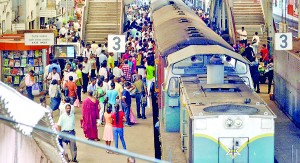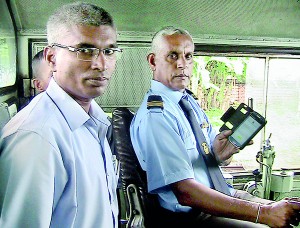
Eleven countries by 48 trains in 15 days
April 19, 2013, 4:32 pm 
By Eng. Asela K. Kulatunga
Secretary-Railway Heritage Trust -
Sri Lanka
Travelling is one of the main categories of enjoyment for many. Those who have high spending power do this on foreign soil and those who cannot afford that satisfy themselves with local trips. However, there are a few in this country who fall into the first category.
Recently, one of my friends, Nimal Perera, a Grade 1 locomotive driver of SLR and a founding member of our Railway Heritage Trust of Sri Lanka, did a magnificent tour of Europe on a small budget saved over the past year untiringly. Due to various reasons, I thought of sharing his experiences with many of our readers who might take-up the challenge Nimal Perera stood up to, in the years to come.
He did this tour with a 1st class Euro-rail pass which cost him about
Swiss Franc 605- Rs. 80,000/-. This Europe-wide trip started from Basel, Switzerland, where he stayed with some of his friends for a couple of days. Initial leg of the tour was from Basel to Hamburg in Germany by the Basel - Hamburg train. This journey took him about 6 hrs. His main intention was to visit the world's biggest miniature railway wonderland. This place has the world's largest collection of railway models, including world famous railway tracks, such as, Grand Canyon of USA. In addition, he went on a city tour which covered most of the monuments and public attractions. He stayed that night in one of the world's most famous budget accommodation hostel chains called Youth Hostel (AO hostel) at Leipzig , Germany.
Following day he visited the Czech Republic via the Berlin to Linz train and had the opportunity of seeing the ancient buildings and art galleries situated in Ceske Bude Jovice. Second night was spent at a hotel of the same city for Crone 300/-. Following day he visited the Slovekian city called Bratislava and stayed the third night at the Youth Hostel (YH) at Corvin Point.
From Bratislava, next, he travelled to a city known as Kosice, which was a 5hrs train journey and situated on the Ukrainian Border. There was a bus service operating from this city to London. In this city our traveller faced some unpleasantness from Gypsies who live there. However, some security personnel supported him to get over the incident. Same day he travelled to the Hungarian capital Budapest and stayed the night at YH there and he was the first Sri Lankan to stay at that hostel, according to the authorities. The next day he visited many palaces in the Hungarian capital and walked along the banks of river Danube and he also took the footpath of the world famous ancient chain bridge. In addition there are many palaces, churches of gothic architecture. According our traveller, Perera, this was the city where he met the most hospitable people he has ever come across in the EU. Most of the PROs of the railway stations were very supportive of visitors.
Same day evening, he took a train to visit the famous BRAMS Castle situated in Brasov in Transylvania (Previous name used for Rumania). From there he took a rail jet to Wien in the Austrian capital the same evening and spent some time at the Wien YH. Next day he went to Semarine highlands through a track full of tunnels and culverts. The track was laid through a part of Alps. Towards night the same day, he returned to the Czech Republic city called Ceske Bude Jovice and stayed the night with a Czech couple, Irena & Jara, known to him.
He was amazed at their hospitality, especially to note the delicious food they served and was impressed that the couple arranged for the next day's bookings as well. On his seventh day he visited the capital of Czech, Prague, which is full of many ancient palaces and buildings and later got on to a train to travel to Berlin where he got the opportunity of having a cab ride as well. That night he got accommodation at YH Berlin, the city full of oriental music players.

Nimal Perera had a most memorable experience on his eighth day of the tour, on his way to Copenhagen, Denmark. This journey involved a 45 minute ferry travel through the Baltic Sea. Here the train initially goes to the ferry and the ferry takes the train to the other shore. At Copenhagen he stayed at DAN hostel and next day went on a city tour organised by the YH, free of charge. That evening he took a train to Sweden, Stockholm, where he arrived the next morning. From there he went to a city called Ostersund on the northern side. This part of the journey went mainly through thick jungles covered with cypress trees. From there, towards early morning, he took a train in the westward direction to cross the Sweden - Norway border to reach a city called Trondheim by 9 pm. During this part of the journey he noticed many freight trains full of logs, including forest cover. On the border, Norwegian Border Police checked the whole train. Even though he travelled during the evenings and early at night, he did not see any difference in the times of day since it was summer for the North Pole. From Trondheim, he moved to Oslo by a night train, and reached there by 6.45 am. He did not stay at any hotels in Norway and Sweden since accommodation and food was very expensive compared to other European countries.
From Oslo, he travelled to Amsterdam of Netherlands via Hallsburg of Sweden and to Copenhagen of Denmark, on the tenth day of the tour. While he was in Amsterdam, he visited famous museums in the city. Same night he took a city night train to reach Basel, Switzerland, where he started the journey. This journey took 12 days, 33 trains and covered nine countries.
The next leg of the tour started on the same day, after having a four hour rest, to get a change of clothing etc., from Luzern via Olten in Switzerland. The original plan was to travel to Milano of Italy via the St. Gotherd line. However, there was an earthslip between Fluelen and Goschenen, and the passengers were moved by buses. That night he spent in Monza in Italy and the next morning he travelled to Milano and stayed with his friends there and had some Sri Lankan food after two weeks.
Next day he visited the world famous church named after St. Anthony of Padua. From there he visited Verona to see the Romeo & Juliet antique house. From there he moved to Milano and took the evening train to reach Tirano, which is last station in eastern Italy and which is on Switzerland border. He stayed the night at a very cheap place for around 30 Euros. Next day, he travelled to St Moritz by the world famous Bernina express which travels in a scenic, mountainous area covering many glaziers, tunnels, viaducts, waterfalls, and precipitous valleys, where his mind went back to the Pattipola-Haputale stretch where he used to drive locos quiet frequently. According to Perera, the stretch between Trerano-Chur and St. Moritz is the best such segment he has covered so far.
The same day he returned to Zurich from Chur, then to Luzern, then to Basel via the beautiful Interlaken. This stretch is known as the Golden Pass due to its scenery. Thus ended the 15- day tour, which covered 11 countries on 48 trains.
Nimal Perera would like to thank the Swiss embassy in Sri Lanka, especially the visa section officials. Further, the sponsors of the tour, Rohan Perera and Hans Sommer, Hans Jurg Moser & Mrs. Brigita in Switzerland and Irena Vagnerova, Jara Vagnerova of Czech Republic, who had given their fullest support during his stay in the Czech Republic and Ms. Ajantha Hostetler of Switzerland and finally to Roland Feer (Loco Crew manager) of Swiss federal railways for interviewing him and Mrs. Annette Fuhrer for publishing an article in the Swiss Info magazine.
Email of mail: nimalperera1960@gmail.com












 Nimal Perera had a most memorable experience on his eighth day of the tour, on his way to Copenhagen, Denmark. This journey involved a 45 minute ferry travel through the Baltic Sea. Here the train initially goes to the ferry and the ferry takes the train to the other shore. At Copenhagen he stayed at DAN hostel and next day went on a city tour organised by the YH, free of charge. That evening he took a train to Sweden, Stockholm, where he arrived the next morning. From there he went to a city called Ostersund on the northern side. This part of the journey went mainly through thick jungles covered with cypress trees. From there, towards early morning, he took a train in the westward direction to cross the Sweden - Norway border to reach a city called Trondheim by 9 pm. During this part of the journey he noticed many freight trains full of logs, including forest cover. On the border, Norwegian Border Police checked the whole train. Even though he travelled during the evenings and early at night, he did not see any difference in the times of day since it was summer for the North Pole. From Trondheim, he moved to Oslo by a night train, and reached there by 6.45 am. He did not stay at any hotels in Norway and Sweden since accommodation and food was very expensive compared to other European countries.
Nimal Perera had a most memorable experience on his eighth day of the tour, on his way to Copenhagen, Denmark. This journey involved a 45 minute ferry travel through the Baltic Sea. Here the train initially goes to the ferry and the ferry takes the train to the other shore. At Copenhagen he stayed at DAN hostel and next day went on a city tour organised by the YH, free of charge. That evening he took a train to Sweden, Stockholm, where he arrived the next morning. From there he went to a city called Ostersund on the northern side. This part of the journey went mainly through thick jungles covered with cypress trees. From there, towards early morning, he took a train in the westward direction to cross the Sweden - Norway border to reach a city called Trondheim by 9 pm. During this part of the journey he noticed many freight trains full of logs, including forest cover. On the border, Norwegian Border Police checked the whole train. Even though he travelled during the evenings and early at night, he did not see any difference in the times of day since it was summer for the North Pole. From Trondheim, he moved to Oslo by a night train, and reached there by 6.45 am. He did not stay at any hotels in Norway and Sweden since accommodation and food was very expensive compared to other European countries.



